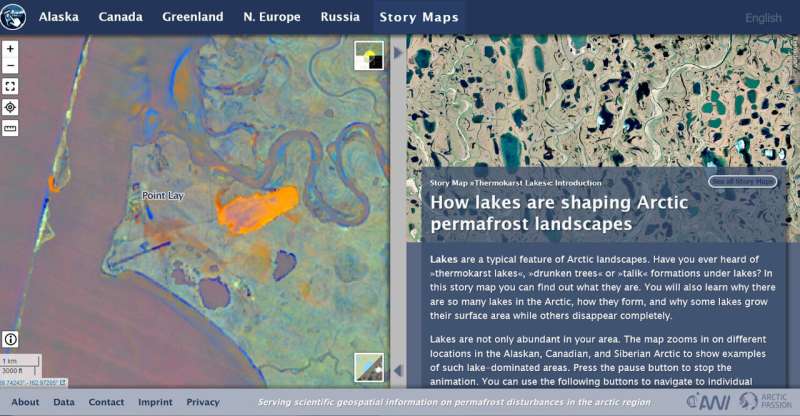This article has been reviewed according to Science X's editorial process and policies. Editors have highlighted the following attributes while ensuring the content's credibility:
fact-checked
proofread
A new map tool for monitoring pan-Arctic trends of permafrost landscape change

Permafrost (from "permanent" and "frost") is ground that continuously remains at or below 0° C for at least two consecutive years. Around 15% of the land surface in the Northern Hemisphere is underlain by permafrost, which often contains and preserves biomass accumulated throughout millennia and thus acts as a carbon sink.
The amount of carbon stored in permafrost is four times the carbon that has been released into the atmosphere due to human activities in modern times (Canadian Geographic, 2018). As frozen soil thaws, microbial decomposition of organic matter releases carbon dioxide or methane, greenhouse gases that contribute to global warming and further increase permafrost thawing at a global scale.
Land surface changes associated with permafrost thaw include the acceleration of Arctic coastal erosion, increased thaw slumping in hillslope regions, and the drainage and formation of lakes, as well as an intensification of disturbances on land, such as forest fires and droughts.
Thermo-erosion leads to gullying, slumping and even landslides, and threatens infrastructure. Information on where these changes in permafrost stability occur in the Arctic and to what extent they are an important factor for the management of the land and infrastructure is scarce.
Many communities living in areas with permafrost have firsthand knowledge of local problems with erosion and thaw subsidence. However, until now, Arctic communities have not been able to receive spatially explicit information on recent or ongoing thaw and erosion at broader scales, providing vital information on how existing infrastructure or planned future infrastructure developments might be threatened. This information would be vital for better management, planning, decision-making, increased safety, and more targeted local responses in Arctic communities, but also to give scientists vital information about the development.
Arctic PASSION has recently published the Arctic Landscape EXplorer (ALEX), which contains data on satellite-derived trends in land surface changes at 30-meter resolution for the entire Arctic permafrost region for the 20 years from 2003 to 2022. The freely-available online tool features an easy-to-use and well-explained map interface and was developed specifically for non-experts to meet the information needs of local Arctic communities living in areas with permafrost.
The work is published in the journal PANGAEA.
The tool includes a localized view of the information provided and a storytelling component, and parts of the website will be available in multiple Arctic languages soon. Consultations with local representatives and stakeholders from Alaska aimed to ensure that their actual information needs are met.
"Dozens of lakes in Alaska have disappeared in recent years. This lake was used as a freshwater source for the village, forcing the community to find an alternative supply. This individual example shows us how communities living on frozen ground are directly affected by rapid changes in their lands," says researcher Tillmann Lübker.
ALEX is part of Arctic PASSION's Permafrost Service: a satellite imagery-derived map product showing changes in permafrost thaw with 30 m resolution on the pan-Arctic scale with the ability to reliably detect and assess regional disturbances such as coastal erosion, lake drainage, thermokarst lake expansion, infrastructure expansion, retrogressive thaw slumps, tundra fires, and fire scars, as well as the possibility to see change over time.
More information: Ingmar Nitze et al, Pan-Arctic Visualization of Landscape Change (2003-2022), Arctic PASSION Permafrost Service, PANGAEA (2024). DOI: 10.1594/pangaea.964814
The ALEX tool may be accessed at alex.awi.de/.
Provided by GRID-Arendal





















